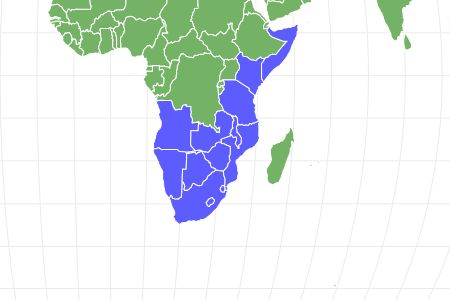African Bullfrog
Pyxicephalus adspersus
The African bullfrog is one of only three species of frog that have “teeth.”
Advertisement
African Bullfrog Scientific Classification
- Kingdom
- Animalia
- Phylum
- Chordata
- Class
- Amphibia
- Order
- Anura
- Family
- Pyxicephalidae
- Genus
- Pyxicephalus
- Scientific Name
- Pyxicephalus adspersus
Read our Complete Guide to Classification of Animals.
African Bullfrog Conservation Status
African Bullfrog Facts
- Main Prey
- Reptiles, small mammals, small birds, insects, amphibians and including other frogs
- Name Of Young
- Tadpole, polliwog, larva
- Group Behavior
- Solitary
- Fun Fact
- The African bullfrog is one of only three species of frog that have “teeth.”
- Estimated Population Size
- Unknown
- Biggest Threat
- Habitat destruction, hunting, pet trade
- Most Distinctive Feature
- Size
- Other Name(s)
- Pixie frog, Giant African Bullfrog
- Litter Size
- As many as 4,000 eggs laid at a time
- Habitat
- Deserts, high veld, floodplains, grassland, savanna, farms, marshes, ponds, lakes
- Predators
- Humans, birds of prey, monitor lizards, turtles
- Diet
- Carnivore
- Type
- Amphibian
- Common Name
- African bullfrog
- Number Of Species
- 1
- Location
- Sub-Saharan Africa
View all of the African Bullfrog images!
The African bullfrog is the biggest frog in sub-Saharan Africa.
The African bullfrog is one of the largest frogs on Earth, with the Goliath Frog being the biggest. Also known as the Giant African Bullfrog, the male of the species can grow to 10 inches long and weigh more than 4 pounds. This bullfrog primarily lives in the central part of sub-Saharan Africa. It is a voracious eater and will swallow anything it can, but is also popular as a pet. One notable characteristic of the bullfrog is the sound it makes when it is annoyed, which has been described as croaking, roaring, or bleating.
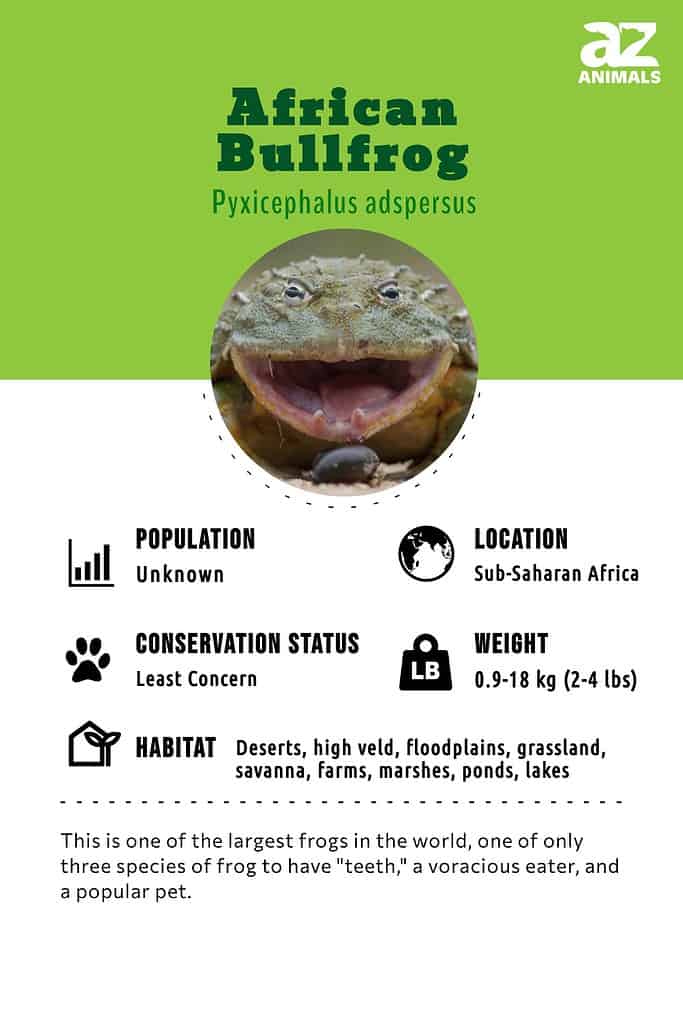
4 Incredible African Bullfrog Facts!
- Interestingly, the frog is also called the pixie frog. This, of course, has nothing to do with the animal’s size. “Pixie” comes from its scientific name of Pyxicephalus adspersus.
- As belligerent as he can sometimes be, the male African bullfrog is a doting father, to a point. If he sees that the pool that holds his tadpoles is running out of water, he’ll use his back legs to dig a channel into a larger pool to both replenish the smaller pool and allow the tadpoles to escape. On the other hand, he’ll sometimes eat his young.
- African bullfrogs shed their skin in its entirety occasionally, splitting down the back first then across its belly so the frog can pull its arms and legs out then work the skin off its head. Not to waste any food source, the frog then eats the old skin.
- After burrowing underground, some African bullfrogs keep just their noses above ground, the better to grab any unsuspecting prey.

African bullfrogs shed their skin on occasion, then eat it.
©Audrey Snider-Bell/Shutterstock.com
Scientific Name
The African bullfrog’s scientific name is Pyxicephalus adspersus. It is a member of the Pyxicephalidae family of sub-Saharan frogs and belongs to the Pyxicephalus genus, which comes from the Greek for “round box head.”
The African bullfrog is the largest of the four species that belong to Pyxicephalus, with the other species being the edible bullfrog (Pyxicephalus edulis), Calabresi’s bullfrog (Pyxicephalus obbianus), and Pyxicephalus angusticeps.
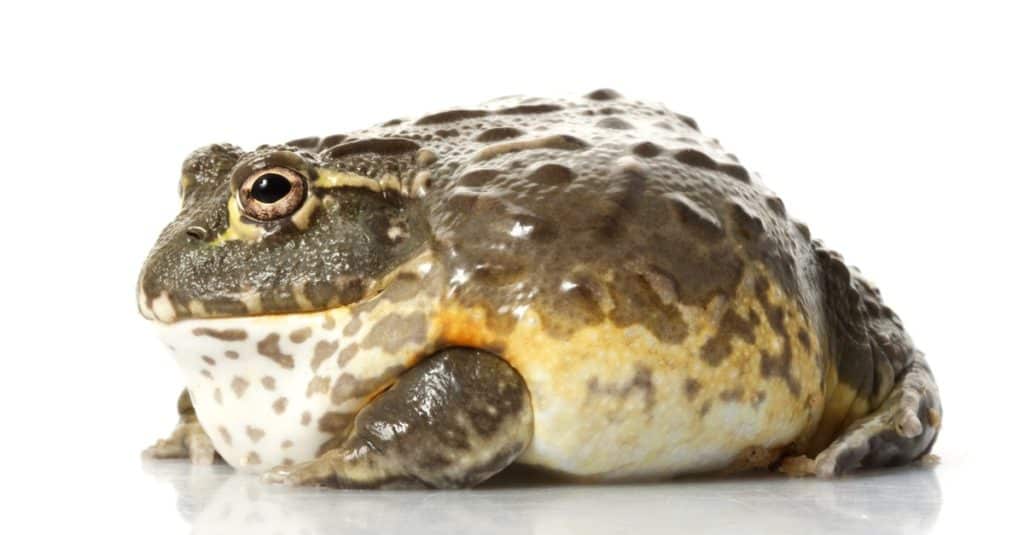
The scientific name of the African bullfrog is
Pyxicephalus adspersus.
©fivespots/Shutterstock.com
Evolution and History
The African bullfrog has evolved in several ways to adapt to its environment.
As the biggest threat to these frog is habitat destruction, they have developed adaptations that allow them to thrive in a range of climates from hot deserts to velds, high open lands that reach below-freezing in the winter. One of the adaptations the frog has developed to stay alive in a hostile environment is when it estivates (becomes dormant), it sloughs off its skin one layer at a time to form a cocoon around itself for protection and to reduce evaporative water loss from its body. While cocooned, the frog decreases its metabolic rate. All of this allows the bullfrog to withstand the African dry season, which can last 7-8 months.
Another adaptation is its odontodes, tooth-like features on its jaw that it uses to grab onto prey and fight off predators. While many frogs have “pedicel” teeth divided into three sections, African bullfrogs have non-pedicellate teeth composed of dentin, with an enamel tip on the crown.
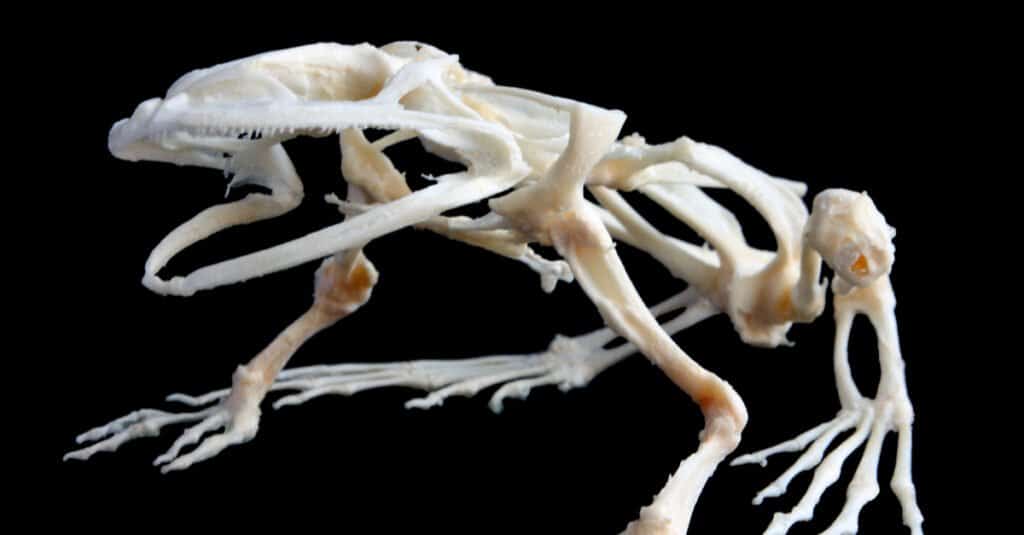
The African bullfrog has evolved in several ways in order to exist in its sub-Saharan habitat.
©photowind/Shutterstock.com
Appearance and Behavior
Male African bullfrogs are almost 10 inches long, while females are about 4.5 inches long. The males of this big frog can weigh a little over 4 pounds, and the females weigh about half that, as they are half the size. This is unusual because in most frog species the females are bigger than the males.
A fully grown male African bullfrog is olive green, has a throat in shades of yellow or orange, and can be as big as a dinner plate. The female is much smaller and olive green to light brown with a white or cream throat. Younger bullfrogs are more brightly colored, with mottled skin and white or yellow lines that run down their back. The colors fade to the adult coloring as the frog gets older, though some females do retain the lines. Adult frogs have a knob on their hind foot shaped like a shovel that helps them dig. Their back toes have some webbing while the stubby front toes do not.
The African bullfrog has a similar body to most other frogs. Its powerful legs help it jump away from predators and threats, and its skin protects its internal organs, helps it take in oxygen, and absorbs water. The skin is also full of glands. Many of these glands are located on the back and head and secrete a solution that keeps the skin moist and protects it against pathogens. Since it’s slick, it also helps the frog escape predators.
The African bullfrog is noted for having a huge skull and robust skeleton, and though they do not have teeth, their bottom jaw has three structures called odontodes. These are growths that are similar to teeth but grow on the top of the skin. Odontodes are adaptations used to grab and hang on to prey. The African bullfrog is one of only three species of frog that have “teeth.”
African bullfrogs are solitary save the breeding season, which happens after a heavy rain that allows shallow, temporary pools of water to form. A group of frogs is called an army or a knot.

The African bullfrog is one of only three species of frog to have teeth-like features.
©Stu Porter/Shutterstock.com
Habitat
The bullfrog can be found in a wide variety of habitats in sub-Saharan Africa. It’s found as far east as Somalia, as far west as Nigeria, and south into South Africa.
Though they are amphibians, African bullfrogs can live in climates that stay dry for years. They can live in the mountains but are probably happiest near bodies of water. The secret to their adaptability is that they dig chambers in the soil when the climate becomes too harsh, enter the chambers and become dormant until conditions are more favorable.
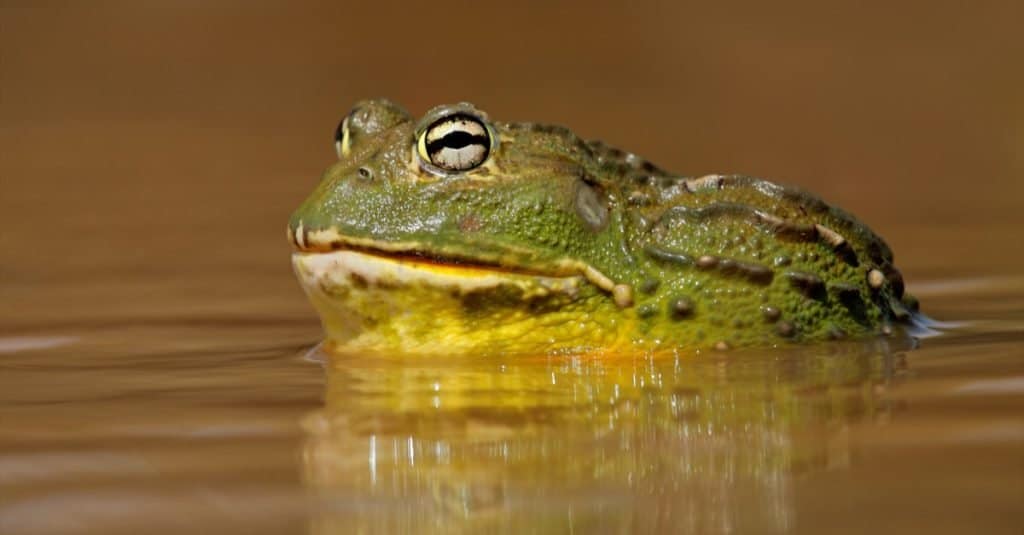
African bullfrogs prefer to be in and near bodies of water.
©EcoPrint/Shutterstock.com
Diet
Like most other frogs, the African bullfrog is a carnivore and eats reptiles including snakes, amphibians, insects, mice and other small mammals, plus small birds. They will eat their own species, and it is rather common for a bullfrog tadpole to begin to eat its brothers and sisters when it emerges from its egg. A father will sometimes make a meal of some of the eggs or tadpoles he is guarding.
It hunts by turning out its sticky tongue, which attaches to its prey and draws it into the frog’s mouth. Once there, it can be held by the dermal teeth while the frog kills it.
A person who keeps the African bullfrog as a pet needs to make sure that it does not try to eat anything that is indigestible, such as toys or other foreign objects. The frog should also not be fed muscle meat such as ground beef, as it doesn’t supply the nutrients the animal needs. Frogs can be subject to infections in their skin and eyes and ammonia poisoning if their enclosure’s maintenance is neglected.
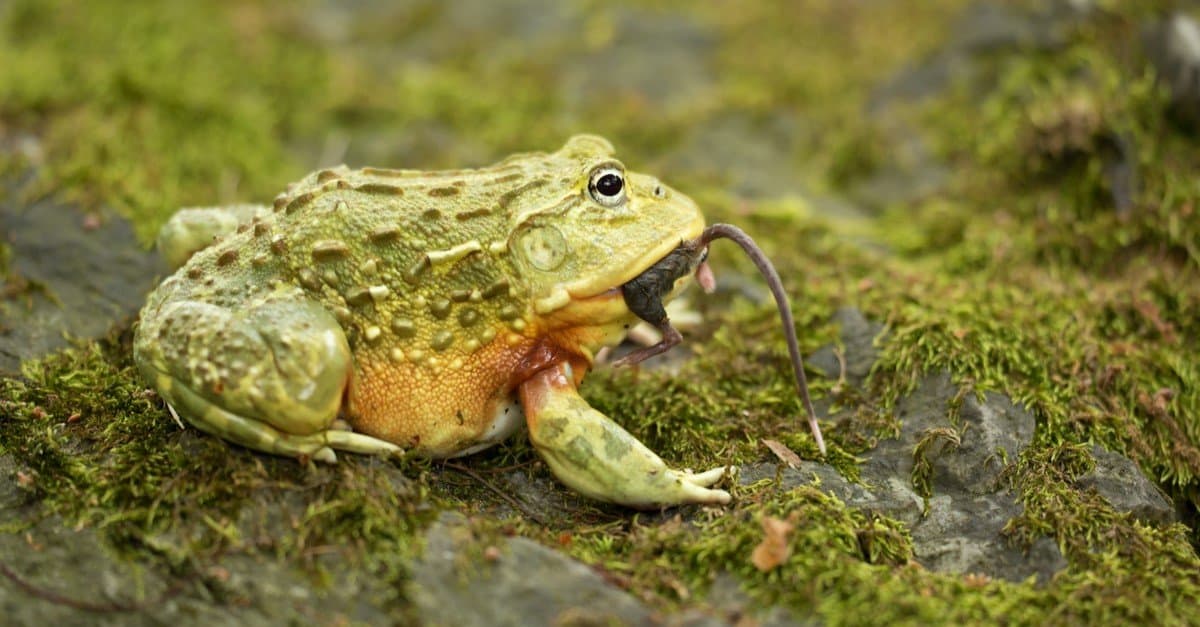
African bullfrogs eat a variety of small mammals like mice and birds, as well as snakes, other reptiles, and insects.
©Milan Zygmunt/Shutterstock.com
Predators and Threats
Natural predators include birds of prey that are big enough to grab the frogs with their talons or beaks and monitor lizards and turtles that attack young frogs and then swallow them.
People who live in the same habitats as African bullfrogs sometimes eat them as they consider their meat to be a delicacy.
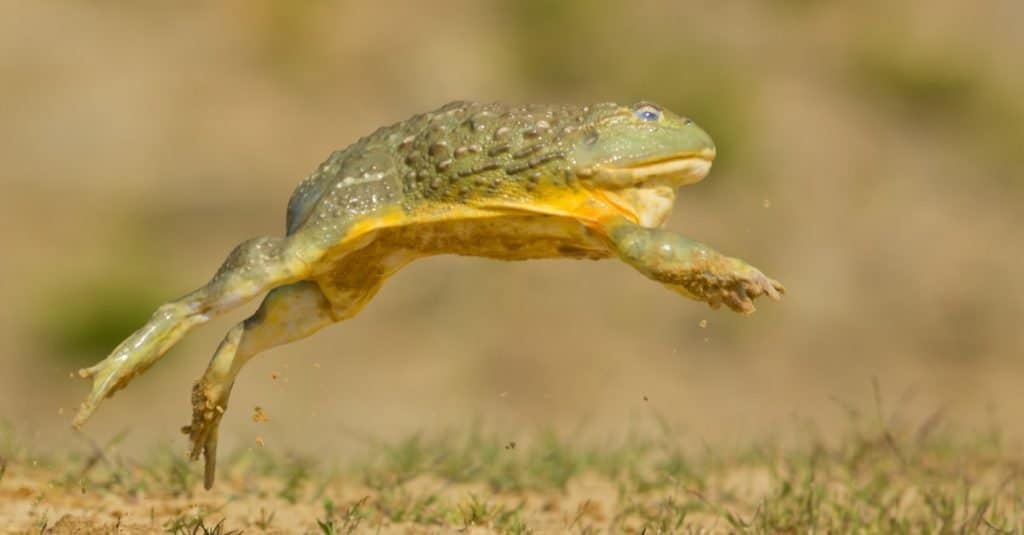
The African bullfrog’s predators include birds of prey and humans.
©Milan Zygmunt/Shutterstock.com
Reproduction, Babies, and Lifespan
The African bullfrog is sexually mature when it’s about 1.5 to 2 years old. During the breeding season, the younger males gather in one small area of the pool while the bigger males go to the center and try to chase each other off. They will sometimes fight to the death to do this. They make a sound that resembles a loud “whoop!” to attract females. The females enter the water and attempt to mate with the dominant male. A female African bullfrog releases up to 4,000 eggs in the breeding pool. Then, she leaves to let the father guard them.
There is no gestation period for the African bullfrog. Once she is clasped by the male she has selected, the female lays eggs on the surface of the water, and the male fertilizes them. The tadpoles hatch about two days later. The young of bullfrogs are called larvae, tadpoles, or polliwogs.
Since African bullfrogs are amphibians, their young do not nurse and therefore do not need to be weaned. They are omnivorous and will consume vegetation, live and dead insects, fish that are small enough to handle, and other tadpoles. As they mature, they turn into exclusive carnivores.
Tadpoles grow into young frogs in about three weeks. If it survives infancy, this bullfrog typically lives around 20 years and has been known to live as long as 45 years in captivity. As they age they may, like other amphibians, be subject to diseases such as chytridiomycosis, which attacks the skin, and other diseases caused by ranaviruses.

Young bullfrogs are omnivorous and only become carnivorous when they mature.
©Vladislav T. Jirousek/Shutterstock.com
Population
Though the exact population of African bullfrogs is unknown, its conservation status is “Least Concern,” although it’s believed their population is declining.
View all 194 animals that start with AAfrican Bullfrog FAQs (Frequently Asked Questions)
Are African bullfrogs carnivores, herbivores, or omnivores?
African bullfrogs are opportunistic carnivores. These giant frogs are notorious for eating nearly anything they can subdue and swallow.
What is the African bullfrog’s skin type?
The African bullfrog’s skin is hairless and slippery. However, it is easier to handle than other frogs because the skin also contains ridges. However, the frog does not like to be picked up frequently.
What is the African bullfrog’s top speed?
African bullfrogs don’t actually run very fast, but they can jump. They usually jump about 3 feet but can jump as much as 6 feet. This would be several times the length of their body.
What is the African bullfrog’s most distinctive feature?
The most distinctive feature of the African bullfrog is its sheer size.
What are the African bullfrog’s other names?
The frog is also known as the Giant African Bullfrog because of its size. It’s also called the pixie frog.
What type of animal is the African bullfrog?
The frog is an amphibian, which means it begins its life in an aquatic environment and moves onto land when it matures. It also undergoes a metamorphosis from a tadpole to an adult.
How much does an African bullfrog cost?
If bought as a pet, the price of an African bullfrog is between $25 and $75.
Are African bullfrogs dangerous?
African bullfrogs aren’t dangerous, but they have a reputation for being rather cranky.
Are African bullfrogs good pets?
African bullfrogs can be good pets if their owner respects their boundaries. Given their size, the price of one of these frogs is fairly reasonable. Like most frogs and other amphibians, they are easy to care for and placid and healthy if their needs are met.
Do African bullfrogs bite?
African bullfrogs can bite, and the bite can be painful, as their dermal teeth are sharp and meant to hold on to struggling prey.
Thank you for reading! Have some feedback for us? Contact the AZ Animals editorial team.
Sources
- Animal Diversity Web, Available here: https://animaldiversity.org/accounts/Pyxicephalus_adspersus/
- Wikipedia, Available here: https://en.wikipedia.org/wiki/Pyxicephalus
- The Spruce Pets, Available here: https://www.thesprucepets.com/african-bullfrogs-1238715
- National Geographic, Available here: https://www.nationalgeographic.com/animals/amphibians/
- Everything Reptiles, Available here: https://www.everythingreptiles.com/pixie-frog/

